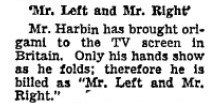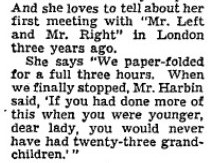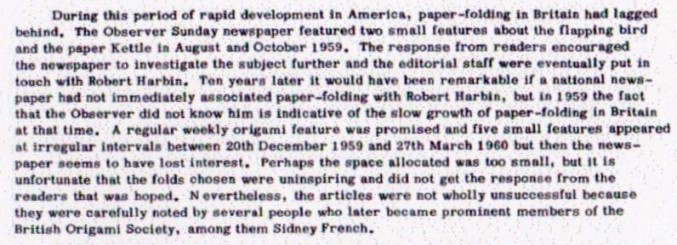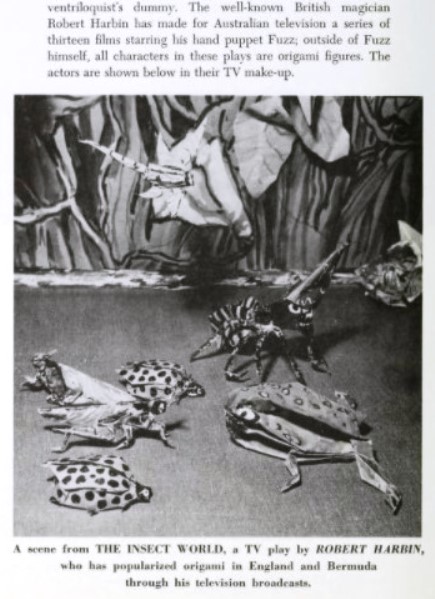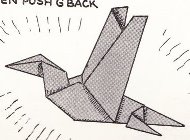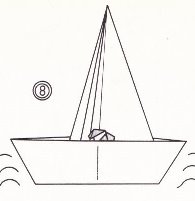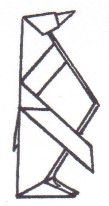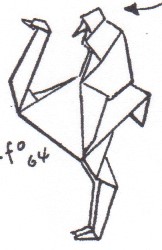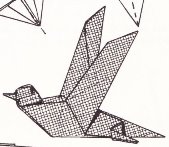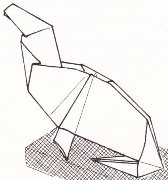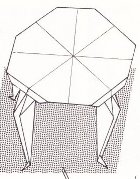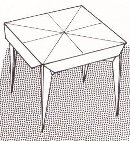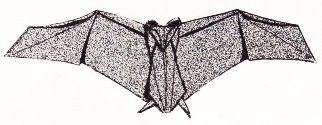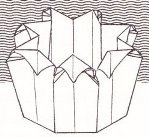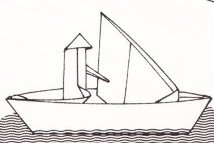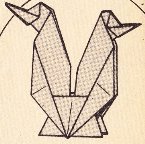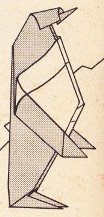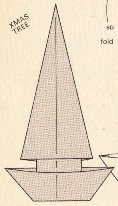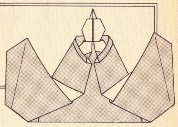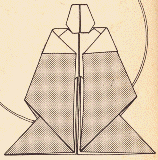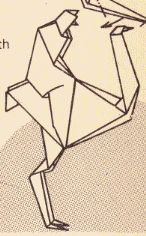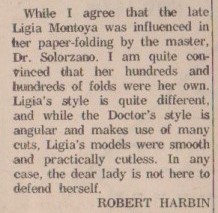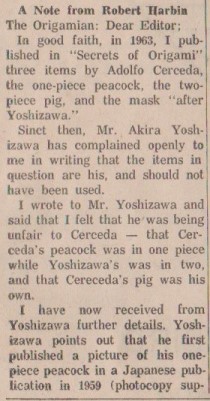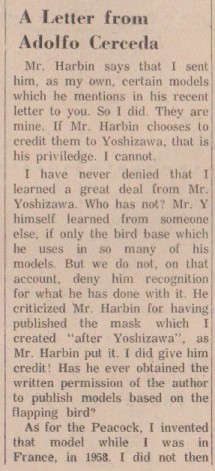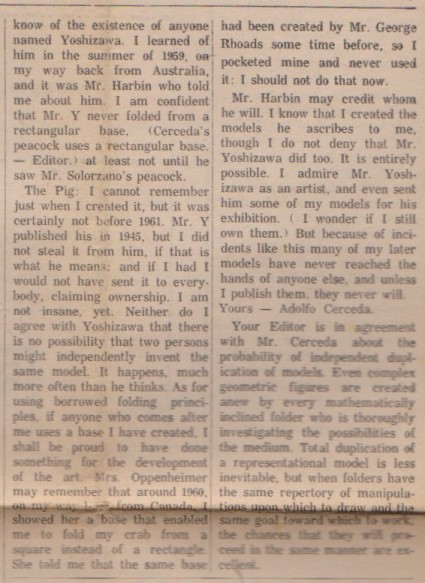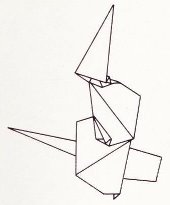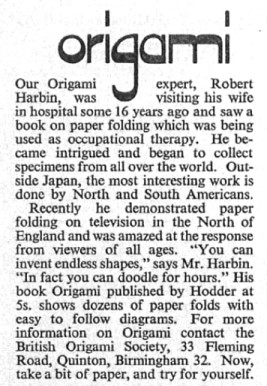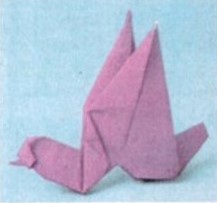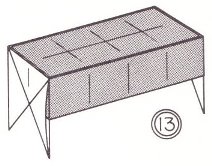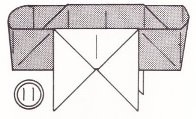| The Public Paperfolding History Project
Last updated 6/3/2024 x |
|||||||
| The Paperfolding of Robert Harbin | |||||||
This page is being used to collect information about the paperfolding of Robert Harbin Iris Walker (1909 to 1978) but is not intended to be a complete or formal history. Introduction Edward Richard Charles Williams was born in South Africa in 1909 and died in London in 1978. He immigrated from South Africa to London in 1928 (1), or possibly 1929, and developed a successful career as a music hall, stage and television magician. At first, he performed as Ned Williams, but in 1932 he adopted the name Robert Harbin as both his professional name and nom de plume. In 1932 he married the dancer Edith Lilian Philp, who used the professional name of Dorothy Hall and was, for a while, his stage assistant. Harbin was highly respected among magicians and was considered one of magic’s most brilliant creative geniuses, as well as a distinguished performer. He invented many ingenious tricks and illusions, among them the famous Zig-Zag Girl. Most were published in the weekly magic magazine ‘Abracadabra’ and in his magnum opus ‘The Magic of Robert Harbin’. Like many other magicians before him, he became an enthusiastic paper folder. He invented many original designs of his own but his most significant contribution to the development of recreational and creative paper folding was made through his books and television appearances. It is probably no exaggeration to say that he introduced more people to origami than any other paperfolder since Friedrich Froebel, particularly in Great Britain. He also used his books to publicise the work of many of the best creative paperfolders of his time. Together with Lillian Oppenheimer and Gershon Legman, he has been credited as being one of the people most responsible for helping to forge closer links between paperfolders in Europe, South America, the USA, Japan and Australasia. ********** Main Sources Consulted There are factual errors in almost all of these sources, which I have tried my best to correct in the chronology below. (1) 'The Genius of Robert Harbin' by Eric Lewis, a biography written by one of Harbin's closest friends within the world of magic. Information from this book has been provided to me by Edwin Corrie. (2) Obituary written by Eric Kenneway in British Origami magazine no 69 of April 1978. (3) 'The History of Paperfolding in Britain' by David Lister, published by the British Origami Society in 1975. (Published while Robert Harbin was still alive and while he was still involved with the British Origami Society.) (4) David Lister, 'Introduction to the Third Edition' of 'Secrets of Origami' by Robert Harbin, Dover, 1997. (5) David Lister on Lillian Oppenheimer and Her Friends - an article by David Lister published on the Lister List. (6) Robert Harbin and Margaret Campbell - an article by David Lister published on the Lister List. (7) Lillian Oppenheimer on Robert Harbin - video on the You Tube channel of Origami USA. (8) Gershon Legman - - an article by David Lister published on the Lister List. (9) 'Profile - Robert Harbin' an article by Lillian Oppenheimer in 'The Origamian' Volume 4, Issue 2 of Summer 1964 (which can be downloaded from the Origami USA website) (10) Robert Harbin - Magicpedia (11) Robert Harbin - IMDb - gives some details of filmography and TV appearances. (12) 'Old Time Variety' by Richard Anthony Baker, published in 2011. ********** Chronology 1909 Born in South Africa. ********** 1920 In his introduction to his book ‘Paper Magic’ Harbin recorded that:
********** 1928 At the age of 19 (or possibly 20) Ned Williams immigrated to London. He seems to have already been an accomplished magician. His first job in London was as a demonstrator in the magic department of Gamages department store in Holborn but he was soon getting work as an after dinner performer. *********** 1930 According to Magicpedia (10) around this time he 'began performing in music halls under the title 'Ned Williams, the Boy Magician from South Africa' According to 'Old Time Variety' by Richard Anthony Baker (12)
According to source (2) the reason for changing his stage name was that another magician called Oswald Williams was managing director of St George's theatre at the time, as well as performing in the shows, and he didn't want two different Williams on the bill. ********** 1939 / 1945 The Obituary written by Eric Kenneway in British Origami magazine no 69 of April 1978 says:
The book jacket of 'Party Lines' (see 1963) states that Harbin ended the war as a Lieutenant Colonel. According to 'Old Time Variety' by Richard Anthony Baker (12):
********** 1947 In his article 'FEATHERS… FEATHERS…' (Personally Speaking – Nov07 – Part 2) Robert Harbin describes how 'Way back in December 1947, I was commissioned to create several different magical effects for the theatrical version of The Wizard Of Oz.' According to 'Old Time Variety' by Richard Anthony Baker (12):
********** 1953 Early in 1953, his wife, Dorothy Hall, suffered severe burns in a dressing-room fire. While visiting her in hospital, Harbin came across some airmen who were folding paper as a form of occupational therapy, using Margaret Campbell’s book ‘Paper Toy Making’ as their exemplar. Although Campbell and Harbin were in fact distant cousins, it does not appear that Harbin had seen this book before. It appears, however, to have made a big impression on him and inspired him to want to write his own book on the subject In the Introduction to his book 'Paper Magic', published in 1956, Harbin says:
Around the same time, Harbin was contracted by the American film director Cy Endfield to appear as the character Harper LeStrade, a magician, in his film ‘The Limping Man’. Endfield was also interested in recreational paperfolding and, seeing Harbin folding paper during breaks in the filming, showed him how to fold a peacock from a bank note. 'The Limping Man’ was released in the UK in November 1953, and in the US in December, which means it must have been filmed and edited in just a few short months. These two incidents reawakened Harbin’s interest in paperfolding and he started to collect as much information about paperfolding as he could, and to try to contact other people who were interested in the subject. Harbin quickly made contact with Alfred Bestall, the illustrator of the Rupert Bear cartoon strip in the Daily Express, who had been including origami designs in the Rupert Annuals since 1946, meeting with him at the Daily Express offices on 15th June 1953. He also contacted the Japanese Embassy in London for information but was led to believe that paperfolding was no longer practised in Japan and that there were no Japanese books on the subject. (Information from letters of the Legman Archives, held at the Museo del Origami, Uruguay.) At some time during this early period Harbin also came across the book ‘Les Petits Secrets Amusants’, written by Jean Jacques Édouard Graves, another magician, under the pseaudonym Le Prestidigitateur Alber-Graves, which was published in 1908. Perhaps influenced by the information given to him by the Japanese Embassy, Harbin mistakenly believed that this book contained the information that ‘paper-folding ceased in Japan around 1889’ (Source: Bibliography in 'Paper Magic') In fact this was a misunderstanding of the original French, which said, not that it had ceased but ‘Aujourd’hui ce genre d’occupation est plus délaissé’ (nowadays this kind of occupation is more neglected in Japan). Here is the original text:
********** 1954 Roy Campbell's Preface to his mother Margaret Campbell's book says, inter alia, 'Unamuno, the greatest living Spaniard, is also a devoted grandparent, and one of his chief joys in his old age is folding paper for his little grandson.' Early in 1954 (or perhaps in late 1953), having become aware that Miguel de Unamuno was a paperfolder of some repute, either through the passage given above or in some other way, wrote, either to Felisa de Unamuno directly, if he knew of her existence, or, more probably, simply to Salamanca University seeking more information. Unfortunately we do not have his letter to know where he wrote or what was said. However, at that time Felisa de Unamuno was in charge of the Museum of Unamuno, which was located in the old Rector's Office of Salamanca University, so that any letter addressed to the university would easily have reached her. (Information from Juan Gimeno). Felisa de Unamuno replied on 25th March, saying, 'Muy señor mío: Aunque un poco tarde, le mando esas cuatro figuras de papel que creo fueron las que inventó mi padre y esos dos moros, que fueron obra de una amiga nuestra, que salió una discípula aventajada de mi padre, en cocotología como él llamaba a este arte. La mesa tiene que ir desarmada para meterla en el sobre y le hago el dibujo para que se haga idea. Las otras figuras son el cerdo, la esfinge y la foca. Desde luego todas las que mi padre hacia era con dobleces, nada de tijeras así que no creo fuera el inventor del pavo que me dibujaba usted. Le deseo que mi información le sirva y me despido de usted sa.' (Information from Juan Gimeno). In English, 'Dear Sir, Although a little late, I am sending you those four paper figures that I believe were the ones invented by my father, and those two Moors, which were the work of a friend of ours, who came out as an outstanding disciple of my father, and like him called this art cocotology. The table has to be disassembled to put it in the envelope and I draw it so you can get an idea. The other figures are the pig, the sphinx and the seal. Of course, all the ones my father made were with folds, no scissors, so I don't think he was the inventor of the turkey you drew for me. I hope that my information is useful to you and I say goodbye to you.' The 'outstanding disciple of my father' Felisa de Unamuno refers to was Natividad Sánchez-Ferrero. (Information from Juan Gimeno.) Diagrams for the 'two Moors', the table and the sphinx were published in 'Paper Magic' in 1956. As far as I know Harbin never published diagrams for the pig or the seal. I have not managed to identify the turkey design to which the letter refers. ********** 1955 In early 1955 Harbin's hands appeared, folding paper, as ‘Mr Left and Mr Right’, in a short segment of the BBC children’s programme ‘Jigsaw’, which was shown on Saturday evenings. ‘Mr Left and Mr Right’ first aired on 2nd January 1955 and ran for six bi-weekly shows (1). (Incidentally, according to the Wikipedia entry for David Lister, 'Lister was interested in Origami since he was young, but took it up in earnest in 1955 after seeing Robert Harbin on television in the children’s show 'Mr Left and Mr Right.') Also in early 1955, when ‘Paper Magic’ was substantially complete, Endfield introduced Harbin to Gershon Legman, a boyhood friend of his, then living in the South of France, who had also been researching paperfolding for a number of years, and with much greater success. Legman was quickly able to correct Harbin’s impression that paperfolding had ceased in Japan and to introduce him to the work of Akira Yoshizawa, and of the Argentine paperfolders Vicente Solorzano and Ligia Montoya. (Information from letters of the Legman Archives, held at the Museo del Origami, Uruguay.) While the main content of the book could not be altered at this late stage, Harbin was able to quote substantially from Legman’s letters, particularly the paragraphs about Yoshizawa, in his Introduction, and to add a much more substantial Bibliography to the work than would otherwise have been possible. These late additions made it a much better, and more influential, book. ********** 1956 'Paper Magic', Harbin's first, and probably most influential, book on origami, was published by Oldbourne (the book publishing wing of Express Newspapers, who also published the Rupert Annuals) in 1956. It was mostly a collection of those traditional Western European designs that Harbin had been able to locate in the literature, or that were shown to him by friends, but also contained a few genuinely Japanese designs (some of the Western designs are said to be Japanese) and some original designs by Robert Harbin himself, the book’s illustrator, the now disgraced Australian entertainer Rolf Harris (who had also appeared on ‘Jigsaw’), and a few other paperfolders. One of the strengths of the book is that Harbin tried to give the origin of the designs he was explaining (although he was not always correct in his attributions). (It is worth noting that 'Paper Magic' was translated into Japanese by Satoshi Mama and published by Ryokuchisha in 1960 as 'Origami Dokuhon' (Origami Reading Book – the same title as Yoshizawa’s 1957 book) under Harbin's real name of Ned Williams. (Information from Edwin Corrie and Juan Gimeno) ********** 1957 According to David Lister (5), early in 1957, the American paperfolding enthusiast Lillian Oppenheimer received a copy of ‘Paper Magic’ as a gift from her son, Bill Kruskal. Oppenheimer immediately wrote to Harbin and subsequently met with him in London when she travelled to London to visit her daughter Rosaly there in April of the same year. According to Lillian Oppenheimer's own account (7), when they met, Robert Harbin showed her all his papers and books on paperfolding. Robert Harbin then told Lillian about Gershon Legman and gave her Akira Yoshizawa's address. According to David Lister’s account (4), she then travelled to France to try to meet Legman, only to find that he was away from home. Nevertheless she began to correspond with Legman, and also with Yoshizawa and the other paperfolders whom Legman and Harbin had made contact with. This paved the way for the rapid growth and development of organised paperfolding in the USA. ********** 1958 According to Lillian Oppenheimer's own account (7), she also met with Robert Harbin on her visit to London the following year. On this occasion, finding that Yoshizawa had not replied to her letters, Harbin told her how poor Yoshizawa was and advised her to send some money with her letters so that Yoshizawa could afford the postage to reply. According to Source (1), in 1958 Harbin moved to Bermuda and 'semi-retired'. However, he only stayed a year and a half, and returned to England in 1959. According to David Lister (3) he taught origami on television while he was there. On 27th June 1958 Meyer Berger's 'About New York' column in the New York Times featured Lillian Oppenheimer and her love of paperfolding. The column was titled 'Origami, the Ancient Art of Paper-Folding, has Gramercy Square Disciple.' It mentions Robert Harbin. a Briton, twice:
********** 1959 / 1960 According to the exhibition catalogue, Harbin contributed a number of designs to the 'Plane Geometry and Fancy Figures' exhibition held at the Cooper Union Museum in New York in the Summer of 1959:
********** David Lister (3) recounts how:
********** And that:
Copies of all the articles mentioned can be found here. It is of interest that the first of Harbin's articles, for his 'Angel', published on 20/12/1959, refers to the Preliminary Fold as the 'Birdhold Base' and the Waterbomb Base as the 'Water Ball Base', showing that he and Samuel Randlett had not yet come to an agreement about standardised names at this date. ********** 1961 Publication of Harbin's book 'Paperfolding Fun', a miscellany of tricks, stunts, puzzles and papercraft items, all of which involve an element of paperfolding. ********** 'The Art of Origami' by Samuel Randlett, which was published by E P Dutton in New York in 1961, contains information about a series of thirteen, presumably short, films Harbin had made for Australian TV featuring origami figures. (I have not been able to find this information mentioned in any other source.) The puppet Fuzz first appeared on 'Jigsaw'.
********** 1963 In 1963 Harbin appeared, folding paper, on the BBC television programme ‘Top Score’, which alternated weeks with the more famous ‘Crackerjack’. (It is worth noting that Mick Guy, the first Secretary of the British Origami Society, came to have an interest in paperfolding through watching these programmes). ********** 1963 also saw the publication of 'Party Lines', a book of tricks, stunts and novelties intended to be performed as entertainment on social occasions, many of which involve folding paper, handkerchiefs or napkins. The book also contains a chapter devoted specifically to origami which includes designs by Akira Yoshizawa, Ligia Montoya, Adolpho Cerceda and the author's 'Bird in Flight' design.
********** 'The Best of Origami' by Samuel Randlett, which was published by E P Dutton in New York in 1963 and by Faber and Faber Ltd in London in 1964, contained diagrams for Harbin's 'Man in a Boat'.
********** 1964 Vol 4: Issue 2 of 'The Origamian' for Summer 1964 contained a profile of Robert Harbin written by Lillian Oppenheimer and diagrams for two of his designs, Penguin and Man on an Ostrich.
*** Harbin’s book ‘Secrets of Origami’, was published in early 1964 (although the copyright date is 1963). This was a very different kind of book from ‘Paper Magic’. ‘Secrets of Origami’ did contain some traditional designs, but the bulk of the book was devoted to explaining the new work of ten creative paperfolders, Robert Harbin himself, and Florence Temko, Ligia Montoya, John M Nordquist, Jack J Skillman, Adolfo Cerceda, Neal Elias, Fred Rohm, Robert Neale and George Rhoads, with all of whom he had begun to correspond since 1953. (This book was widely promoted in the weekly magic magazine 'Abracadabra', to which I was then subscribed, and as a result I asked my parents to buy it for me for my 12th birthday.) Harbin's own designs included inthe book were: Bird in Flight
********** Japanese Blue Pheasant and Mate
********** Seal
********** Harbin's Macaw
********** Queen Anne Table
********** Card Table
********** Harbin's Bat From an equilateral triangle.
********** Fancy Bowl From a hexagon
********** Fisherman in a Boat
********** ‘Secrets of Origami’ was also one of the first books to use the so-called Yoshizawa-Randlett notation system which standardised the symbols used in origami diagrams, to the development of which Harbin had substantially contributed in the course of a correspondence with Samuel Randlett. ********** During the course of this correspondence, Randlett and Harbin had also co-ordinated the contents of 'Secrets of Origami' and Randlett's book 'The Best of Origami', which was also published in 1964. 'The Best of Origami' contained Harbin's 'Man in a Boat' design and a brief paragraph about Harbin which read:
********** 'The Origamian' Volume 4, Issue 2 of Summer 1964 contained a review of the newly published 'Secrets of Origami' and diagrams for Harbin's 'Penguin' and 'Man on an Ostrich' designs. ********** 1968 Publication of Harbin's ‘Teach Yourself Origami’, by The English Universities Press, 1968 (republished in paperback as ‘Origami: The Art of Paper-Folding’ in 1969, which, in this guise, and later as 'Origami 1', became a best-seller), which included a number of design's by the author: Penguins
********** Penguin 2
********** Xmas Tree
********** Decoration 1 ********** Japanese Gentleman
********** Japanese Lady
********** Ostrich with Rider
********** According to Nostalgia Central, between 1968 and 1972, Robert Harbin presented 32 ten minute long episodes of 'Origami', an ITV afternoon show in each of which he demonstrated how to fold objects such as birds, animals and flowers. Somewhat unfortunately, from today's perspective, 'The show also featured a “Japanese” girl – who was, in fact, Leeds actress Anita Kay in a wig and kimono with lots of makeup. Anita Kay was subsequently succeeded in the role by Cherry (surname not known) and Me Me Lay (who may have been of Chinese ethnicity). Information from https://www.youtube.com/watch?v=hrFcwK-upu8 which also features a clip, possibly some kind of trailer, from one of the shows. Harbin also contributed a number of related articles about paperfolding to ITV's 'Look-In' magazine during this period. ********** 1969 Vol 9: Issue 2 of 'The Origamian' for Summer 1969 contains a letter from Robert Harbin contesting some of the assertions Dr. Solorzano made in his letter about Ligia Montoya published in Volume 8, issue 4.
*** The same issue also contains another letter from Robert Harbin stating that Akira Yoshizawa has claimed priority in two designs, the one-piece peacock and 2-part pig, both of which were published in 'Secrets of Origami' as the work of Adolpho Cerceda.
********** Vol 9: Issue 3 of 'The Origamian' for Autumn 1969 contained a letter from Adolpho Cerceda responding to Robert Harbin's letter in Volume 9, issue 2.
********** 1970 Harbin's 'Welsh Witch' design appeared in Issue 13 of the 'Flapping Bird':
********** Harbin was the 'origami expert' for an article published in Woman's Own magazine of March 1970, which, inter alia, included a photograph of one of his own bird designs.
********** 1971 Publication of ‘Origami 2: The Art of Paper-Folding’, Hodder, 1971. ********** 1972 Publication of ‘Origami 3: The Art of Paper-Folding’, Hodder, 1972 ********** 1973 Acccording to Scotland On Air the television play 'Tobias and the Angel' which featured an animated origami sequence, designed by Robert Harbin, was first broadcast on ITV on 23 December 1973. The articles goes on to say 'There are believed to be no surviving copies'. This play is also mentioned in the Introduction to 'Origami 4' (see 1977), which states, presumably erroneously, that it was screened on the BBC:
********** 1974 Publication of ‘Origami: A Step by Step Guide’, Hamlyn, 1974. ********** Harbin's 'Tubble' (a tub that turned into a table and vice versa) appeared in Issue 20 of the 'Flapping Bird':
********** 1975 Publication of ‘Have Fun with Origami’, by Severn House, 1975. ********** 1977 Harbin became ill with cancer in 1977, shortly after finishing the diagrams for his final book, ‘Origami 4’, which was published by Hodder in paperback that same year. ********** 1978 Robert Harbin died on January 12th 1978 in London, England. Having no siblings or children, he bequeathed the copyright in his books to the British Origami Society and thus helped to make that fledgling society financially secure. In addition to his Obituary, British Origami Magazine 69 of April 1978 contained diagrams for Harbin's 3-part 'Devil' design, which had featured in the television film 'Tobias and the Angel' (see 1973). ********** |
|||||||






